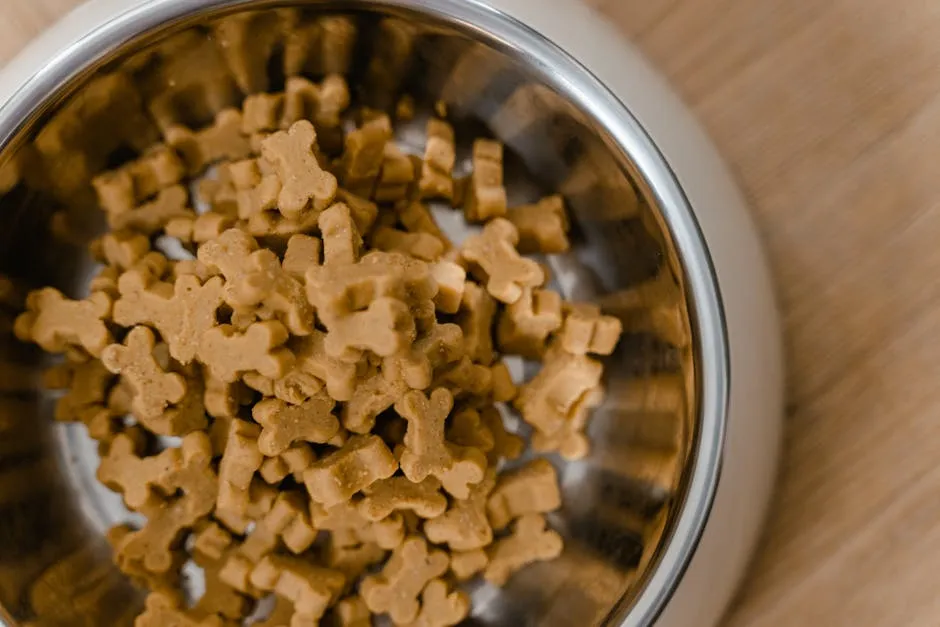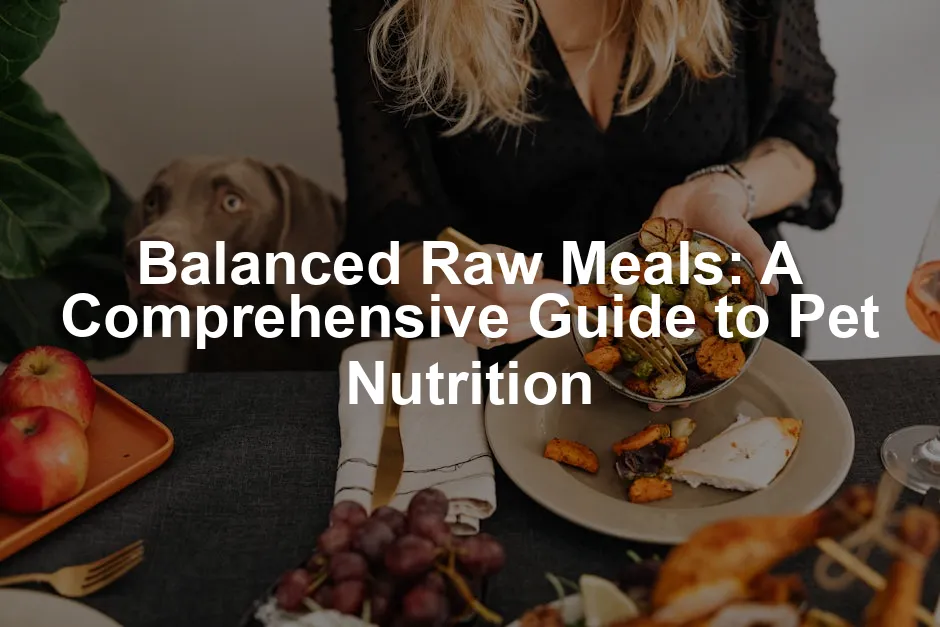Introduction
Balanced raw meals for pets are gaining traction. Many pet owners are opting for raw feeding to provide natural diets. It’s essential to ensure these diets are nutritionally balanced for optimal pet health.
Understanding the principles of raw feeding can help you provide a healthier diet for your pets.
Summary and Overview
Balanced raw meals consist of fresh, unprocessed ingredients. A complete and balanced diet is crucial for pets to thrive and maintain health. Raw feeding can improve digestion, skin conditions, and energy levels. However, misconceptions abound, such as raw diets being unsafe. This guide will clarify these myths and offer practical insights. You can expect to learn about the key components of balanced raw meals, health benefits, and tips on preparing them safely at home. Let’s ensure your pet’s diet not only meets their nutritional needs but enhances their overall well-being!
To help you get started on this raw feeding journey, consider checking out this Raw Dog Food Recipe Book. It’s packed with delicious and nutritious recipes that will keep your furry friends happy while ensuring they get all the nutrients they need!

Understanding Balanced Raw Meals
What Are Balanced Raw Meals?
Balanced raw meals consist of fresh, unprocessed ingredients for pets. This approach emphasizes the importance of raw foods over processed ones. Raw diets can closely mimic natural feeding behaviors observed in wild animals. By providing a variety of proteins, fruits, and vegetables, you ensure that your pet receives essential nutrients.
Choosing raw foods can lead to better overall health for your furry friends. They often thrive on diets that resemble what their ancestors consumed. This method of feeding can lead to improved digestion and increased energy levels. With balanced raw meals, you create a diet that supports your pet’s well-being, vitality, and health.

To keep those raw meals fresh and safe, a good Pet Food Storage Container is essential. It keeps your pet’s food fresh and free from pests, ensuring that every meal is as nutritious as possible!
Health Benefits of Balanced Raw Meals
Balanced raw meals offer numerous health benefits for pets. First, these diets improve digestion and enhance nutrient absorption. Fresh, raw ingredients are easier for pets to digest compared to processed options. This leads to healthier stools and less gastrointestinal upset.
Another benefit is enhanced coat and skin health. Pets on balanced raw diets often show shinier coats and healthier skin. Additionally, these meals can boost the immune system, reducing allergies and sensitivities. Many pet owners report increased energy and vitality in their pets as well.

Finally, balanced raw meals can assist with weight management. By providing proper nutrients without fillers, pets can maintain a healthy weight. Overall, these meals support a happier, healthier life for your beloved companions.
Key Components of a Balanced Raw Diet
Macronutrients: Proteins, Fats, Carbohydrates
Proteins are crucial for your pet’s health. They support muscle development and repair tissues. Quality protein sources include chicken, beef, and fish. These proteins provide essential amino acids that pets need to thrive.
Healthy fats and oils play a vital role, too. They supply energy and promote a shiny coat. Omega-3 and omega-6 fatty acids are especially important. These can be found in fish oils and flaxseed. They help reduce inflammation and support overall health. To make it easy, check out some Fish Oil for Dogs that are highly recommended by pet owners!
Carbohydrates and fiber from fruits and vegetables are also essential. They provide energy and aid digestion. High-fiber foods, like sweet potatoes and peas, help maintain a healthy gut. Including a mix of colorful fruits and veggies ensures your pet gets a wide range of nutrients.

Essential Vitamins and Minerals
A balanced raw diet requires various essential vitamins and minerals. Key vitamins include A, D, E, and B-complex vitamins. Minerals like calcium, phosphorus, and potassium are crucial for bone health and metabolic functions.
Common deficiencies in raw diets often stem from a lack of variety. To avoid this, rotate ingredients frequently. This helps meet your pet’s nutritional needs effectively. Including different protein sources, organ meats, and fresh produce ensures a complete diet.
Variety is vital when sourcing ingredients. It not only prevents deficiencies but also keeps your pet interested in their meals. Aim to incorporate a wide range of foods to create nutritious, balanced meals. This approach supports your pet’s overall health and well-being.

Suggested Ingredient Ratios
When crafting balanced raw meals for pets, ingredient ratios matter. A common guideline suggests 70% muscle meat, 10% raw bone, and 5% organ meats like liver. This composition ensures your pet gets essential nutrients.
However, these ratios may vary depending on your pet’s age, size, and health. For puppies, consider increasing the protein content to support growth. Older pets may benefit from leaner cuts. Always consult your vet to tailor these ratios to your pet’s specific needs.

Sourcing Ingredients
Sourcing high-quality ingredients is crucial for balanced raw meals. Look for fresh, human-grade meats and organic produce. Local butcher shops often provide quality meats suitable for pets. Farmers’ markets can also be a great source for fresh fruits and vegetables.
When handling raw ingredients, prioritize safety. Wash your hands and utensils thoroughly to avoid cross-contamination. Store raw foods safely in the refrigerator or freezer. Following these steps ensures that your pet enjoys nutritious and safe meals.

Recipe Ideas for Balanced Raw Meals
Creating balanced raw meals doesn’t have to be complicated. Here are a few simple recipes to get started. For a basic chicken meal, mix 2 pounds of chicken, 1 cup of chopped carrots, and 2 ounces of liver. Blend everything and portion into servings.
It’s essential to rotate proteins and ingredients regularly. This practice helps provide a wider range of nutrients. Incorporate seasonal vegetables and fruits for added variety and freshness. Remember, a diverse diet keeps mealtime exciting for your furry friend.

Don’t forget to have the right tools in your kitchen! A Dog Food Scale can help you measure the right portions, ensuring your pet gets just the right amount of food!
Meal Planning and Preparation Tips
When preparing balanced raw meals, batch preparation can save time. Start by prepping larger quantities of protein and veggies. Store your portions in airtight containers. This keeps food fresh and makes mealtime easier.
Transitioning your pet to a raw diet should be gradual. Begin by mixing a small amount of raw food with their current diet. Slowly increase the raw portion while decreasing the old food. This helps avoid digestive upset.
Safety is key when handling raw ingredients. Always wash your hands and utensils after touching raw meat. Keep raw food separate from other foods to prevent cross-contamination. Store raw meals in the fridge or freezer to maintain freshness and safety.

Addressing Common Concerns
Myths About Raw Feeding
Many misconceptions surround raw feeding. One common myth is that raw diets are dangerous. However, with proper preparation, raw feeding can be safe. Another misconception is that pets can’t digest vegetables. In fact, pets can benefit from plant ingredients when prepared correctly.
Research shows that many pets thrive on raw diets. Raw foods provide essential nutrients that support overall health. Educating yourself on these facts can help dispel these myths and encourage a balanced approach to pet nutrition.

Veterinary Considerations
Before switching your pet to a raw diet, consult your veterinarian. A professional can help identify potential health risks. They can also guide you in creating a balanced meal plan tailored to your pet’s needs.
Health risks may include nutritional deficiencies if the diet isn’t well-planned. Regular veterinary check-ups can monitor your pet’s health. Discussing your pet’s specific needs will help you mitigate these risks effectively.
Conclusion
Balanced raw meals can significantly benefit your pets. Improved digestion, energy, and overall health are just a few advantages. Remember to consider your pet’s unique needs when planning meals. Consulting a professional ensures a tailored approach for optimal nutrition.

For those looking to add a bit of fun and excitement to your pet’s life, consider some Dog Chew Toys. They can keep your furry friend entertained while also helping with dental health!
Please let us know what you think about our content by leaving a comment down below!
Thank you for reading till here 🙂
All images from Pexels





